History of Bertsolaritza
Pre-history
The first example of improvised bertsolari verse-singing as we know it today dates back to the beginning of the 19th century, although it may be said that the phenomenon of improvisation goes back to prehistoric times. After all, homo sapiens has lived out 95% of his existence without knowing what it is to write. According to historical experts, the oral tradition goes back 10,000 years: “There are four phases in the evolution of mankind: the hunter, the shepherd, the farmer and the miner. We can certainly date the first bertsolaris back to the shepherding era.”
From then until the 15th century, the “profazadoreak” (female singers who went singing from village to village), epic minstrels (singers of war songs and laments) and mourners were the maximum exponents of the oral tradition. Proof of this is furnished by the Arab historian Al-Makari, who says of the 9th century female Basque slaves that “they were easily distinguishable by their elegance, their excellent voices, education and culture.”
Esteban Garibay (1533-1599) identified the 14th century as the century of “female improvisers”, narrating the highlights of the oral tradition over the previous two centuries. There were other jewels, however, in this treasure: Verses on the death of Lasturko Milia (beginning of the 15th century), the Aramayona song (1443), the song of Berdabio’s son, the Urrexola song (1434-1449), and a host of undated poetry collections etc.
Thus, until the 16th century, Garibay, Zaldibia and Isasti were the first historians to compile songs. Some of these are epic poems, others are elegies or laments sung by women on the deaths of their families and loved one (cruel and violent, in general). By way of example we could mention the Berterretxen Kantoria – although it appeared in 1440, it was not written down by the folklorist Salaberry until 1870.
According to research, the kopla was the basic metre scheme used in the Middle Ages. The simplest form was a companion to bertsos in Basque fiestas and celebrations, in Bizkaia in particular, whether or not the occasion was a ronda (around the streets). Although many, many verses were learnt off by heart, the refrains led to improvisation, as in the modern tradition. In any case, the oral tradition has considerably altered the content of today’s songs, and so it is rather difficult to establish their origins.
The oldest references
The above proves the existence of singing, chants and elegies, but the first indisputable evidence of the art within society did not appear until 1452. The ancient Bizkaia Council Laws make two references to female improvisers, and the text in Spanish shows the severity of laws at the time:
Section 35, Law 6. “The way in which mourning may be carried out for the dead ... they laid down in law that hereinafter, when someone dies in Vizcaya [...] no person may dare tear their hair or scratch their face, nor may they go bareheaded, nor sing laments, nor dress in mourning, punishable with one thousand maravedíes for each person on each occasion.”
Section 8, Law 1. “... and in relation to women, known for shamelessness, causing disturbances and singing defamatory songs (known as “profazadas” by the Council).”
One hundred years later, in 1545, the Council of Trent sided with anti-female legislation in Bizkaia: St. Paul’s phrase “mulieres taceant in Ecclesia” (women must be silent in Church) caused immediate reaction in the Basque Country.
The same year saw the beginnings of Basque literature: Bernart Etchepare wrote the first book in Basque, Lingua Vasconum Primitiae, in 1545, and in it we find many poems and songs. This was obviously the first step from oral to written. The second book was written in 1567 by Joan Perez Lazarraga; one hundred pages of shepherds’ stories, epic tales and songs of love, which remained undiscovered until the year 2004.
It is clearly difficult to glimpse the historical reality of the oral tradition. Suffice it to say that it existed, since until the tape recorder arrived, the verses handed down from generation to generation remained in popular memory for years and years, and tended not to be true to the original. One of the first performances was in 1801.
First bertsolari performance
Fernando Amezketarra sang two memorable songs at a performance in Azpeitia in 1799, and a fine contest was held in Villabona two years later. 4,000 spectators gathered in the village square for the competition between Zabala and Txabalategi. There were five ounces of gold at stake; Txabalategi brought along the Aizarnazabal sacristan as a judge, Zabala presented his countryman Fernando Bengoetxea Amezketarra, and the mayor of Villabona chose a priest, Jose Mendizabal, to have the casting vote. There was much, however, they could not decide, leading to the first tie in a bertsolari competition (and this was what made the occasion so memorable). Most of the surviving metres from this performance are zortziko and bederatziko txikiak. The technical expertise and knowledge of the bertsolaris at this time was amazing. Tight metering was no problem to them – they were armed with many, many rhymes. Two stages were set up side by side in the centre of the square for the performance.
Bertsolari competitions became more popular over the first forty years of the 18th century. The local authorities had two very different attitudes – some villages in Gipuzkoa organised a number of contests, whereas the authorities in other villages punished and fined the performers. In fact, the situation varied considerably throughout the Basque Country: the oral tradition survived in Bizkaia and the north of Araba; Zuberoa province forged links between villages with pastoral symphonies; in Nafarroa and a large part of southern Araba the romance ballads absorbed all improvised expression, and it was between east Bizkaia and Lapurdi and Nafarroa, areas protected from foreign cultures, that bertsolaris found the best eco-system to develop their art.
Even so, the expansion of this eco-system was much more extensive than one might have thought. For example, Bautista de Gamiz has left us some written material from the 17th and 18th centuries, and some songs were also written by the Carlist Zeferino Lopez de Ilarraza in 1870, found alongside other anonymous material in Araia.
Fernando Amezketarra (1754-1823), Zabala, Txabalategi and Izuela (1780-1837) were the most noteworthy bertsolaris of the time. Among other abilities of improvisation, Pastor Izuela was reputed to have an astonishing memory. According to those who wrote the stories of history, in one contest against an opponent from Urdaneta, the contest ended in a tie. To decide the winner, the judges instructed the contestants to repeat the entire performance, and Pastor Izuela was able to repeat all 50 verses he had just improvised. It was also during this period that we find the first indications of bertsolaris in Nafarroa, with verses by Martin Olaetxea in 1830. In any case, bertsolaris were not “official” in Nafarroa until 1936, at the Basque Country Championships.
Bertsolari art was non-academic, and nobody studied it: reading and writing verses were both unheard of. The best-known bertsolaris were the product of Basque farmsteads, those who sang of the humbleness of their villages and their inhabitants with the local accent.
Protest and innovation
Since this was a phenomenon directly relating to society, it cannot be denied that the Carlist Wars (1833-1839, 1872-1876) also had an effect on bertsolaris. Basque society was divided. Protests were made, and local people had little time for leisure. Written verses, however, were to play a key role in publicising their protests. Giving out written copies of the same piece was easier than the performer singing it from square to square, and so written material became more popular at the expense of actual singing.
Another reason for the recovery of bertsolaris was time itself, or rather development over time: industrialisation, steam-powered machinery, the train... although innovation was initially a shock to society, written verses softened the blow and also became the best form of publicity and integration. The unschooled bertsolaris of the time were illiterate, and needed relatives, friends or acquaintances to write down the verses they had in their memories (this was to give rise to the sale of such verses).
Xenpelar (1835-1869), Iparragirre (1820-1881), Bilintx (1831-1876) and Pierre Topet (“Etxahun” - 1786-1862) were perhaps the most memorable performers of the time. Xenpelar was a significant impromptu performer; Iparragirre sang his rhymes with guitar accompaniment; Bilintx and Xenpelar both reached new heights in terms of written verses, whilst Etxahun proved that the art was very much alive in the northern Basque Country too.
Txirrita was no friend of the Spanish politician Antonio Cánovas del Castillo; it was said that Basque nationalism emerged the very day that the Basques lost their ancient “Fuero” laws. Thus, if by that stage the Basque people were already demanding the restoration of many of their ancient rights, this situation intensified between 1876 and 1935. Written verses were to become a weapon, thanks to Txirrita and Pello Otaño in particular.
Moreover, we have no way of telling what was the precise situation of improvised singing at that time, but we know for certain that performances increased with the floral games. These were competitions to promote oral literature and poetry. The first floral games were held in Toulouse in 1324 to promote Provençal poetry. Centuries later, the scientist and philanthropist Antoine d’Abbadie brought them to the Basque Country - to Urruña, in fact. They began in 1851, and were one of the mainstays of bertsolaritza for some fifty years. These events also took the performers beyond their normal perimeters of activity, and the judges and prizes improved the quality of the songs, even though on many occasions there were disagreements on judgments. The number of bertsolaris also increased during the festivities.
Written verses constitute an incomparable chronicle of the transformation of the spoken word to the written word. It was not the first time that bertsolaris had attempted to explain changes, innovation or novelties. Txirrita, for example, provided a brilliant reflection of both society and the context of his era via written verses: the loss of the Basque Fueros, the War in Cuba (1898), the First World War, the Second Carlist War, the murder of Antonio Cánovas del Castillo (1828-1897); sport, regattas, boxing (Uzkudun, Basque Country vs. Joe Louis, USA); religion, church life, the Pope, the Goizueta missions, Adam and Eve; social topics, farm work, strikes in the port at Pasaia, Basque emigration to the Americas etc.
Industrialisation gradually appeared as a topic, since the bertsolaris had also boarded the train of progress. The beginnings of nationalism and political change brought on many changes. On the subject of the Basque language, the theories put forward by Sabino Arana (1865-1903) were of little help. In fact, purists looked down on uneducated performers in Gipuzkoa, who used Spanish words to conceal their lack of schooling.
Many of the rhymes were also officially requested at this time. Pello Errota, for example, sang many verses at the request of brides, grooms and newly-weds.
From the bar to the stage
In addition to the occasional floral games, the most popular eco-systems for improvised singing were cider houses, bars and inns. The bertsolari was an unschooled buffoon, a drunkard entertaining the public. This was how Basarri (1913-1999) first started, in his parents’ bar. Like many other bertsolaris, he felt it was his duty to take the art of improvisation away from the restricted space of the bar. Before Basarri, however, Kepa Enbeita (1878-1942) and Pello Otaño (1857-1910) had already impregnated the art with a certain amount of dignity. Correction of verses by Otaño, the open character of Enbeita, and the way in which they approached topics formed the basis of a new type of bertsolarismo.
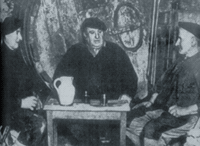
Thus, in an attempt to establish some sort of reality, the consequences of the movement begun by Jose Aristimuño “Aitzol” (1896-1936), Manuel Lekuona, Juan Jose Makazaga, Basarri and a number of others (some mention should be made of the foundation of the Euskaltzaleak group) was the first Basque Country Bertsolari Championship. This was the first step in the “professionalisation” of bertsolaris, which took the art from the bar out into the street, the village square, the fronton, the theatre, the cinema and the church.
The championship brought on many changes:
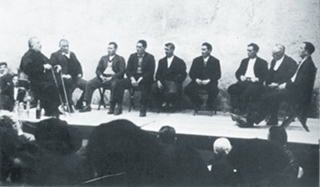
Theme-setters: subjects, which until then had been real topics, became fictional;a fiction close to reality, naturally. The bertsolaris of the time felt that those setting the topics should themselves be bertsolaris, since the topics were supposed to be presented in verse as well. Aitzol was the first to present them in this way.
Organisation: a group or association had to make arrangements for the contest. In 1935 only a few bertsolaris took part, but subsequently it was found necessary to enlist the assistance of certain groups.
Judges: if the work of the judges was difficult enough judging between two bertsolaris, a contest with many more would have to use a much more complex system.
The contests considerably reduced the duration of performances in cider houses and bars, and created a general infrastructure. Uztapide, Balendin Enbeita and Lazkao Txiki also formed part of this new era.
It was professionalism which won the 1935 championship together with Basarri, and Txirrita was obliged to accept fifth place. A year later, however, Txirrita won the contest, even though one of the judges informed Manuel Olaizola that Uztapide had won fair and square. However, Txirrita was now dying. If there had been a contest in 1937 he would have won, assuming Basarri had not taken part and Franco had not driven the art into the darkness of clandestinity. Unfortunately, the Civil War broke out shortly after the death of Txirrita, who had no sons to send to the front.
Between 1940 and 1950 there was severe censorship under the dictatorship of Francisco Franco (1892-1975), the Spanish “Caudillo” or leader. The fear of punishment and fines grew, no political topics could be voiced, and so bertsolaritza as a chronicle of the oppressed was heavily censored. Bertsolaris had to “learn to walk a glass stairway”. In clandestinity, Basarri and Uztapide performed many times in village squares in the Basque Country, a task beset with a host of difficulties.
Bertsolaris from the social viewpoint
As of 1960, bertsolaritza became a mechanism to denounce social repression. Following the disappearance of protectionism, Lopategi and Azpillaga (in the south) and Xalbador and Mattin (in the north) promoted the art as a means of expression. Bertsolaritza became a defensive tool: the Ez Dok Hamairu group, for example, sang tirelessly of the repression of Basque culture. The survival of Basque culture between 1968 and 1980 was in any case no easy task.
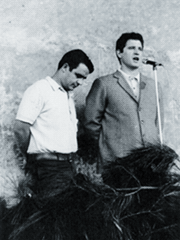
In general, it may be said that the art gradually began to take root between 1935 and 1968. In addition to competitions, verses began to appear in the media, on the radio and in newspapers.
The end of Franco’s dictatorship unleashed a great thirst for freedom. The Basque Country Championship was reorganised in 1980, and Xabier Amuriza was the winner in 1980 and in 1982. The contests in the 1980s were completely different to those of the 1960s. The spectators, who until then had appeared so homogenous, became much more heterogeneous since the bertsolaris had now opened up their area of activity.
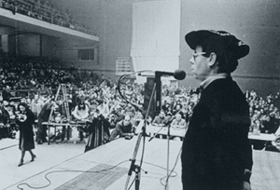
The reality of modern age
The popularity of fiestas grew considerably as of 1977. Students began to study the art at special schools – Sarasua or Euzkitze, for example – and here Amuriza was of incalculable assistance. Bertsolaris began to appear on television, on the radio and in the press, and their public increased at the same giddy rate. Bertsolaris were also transformed into an advertising strategy. Just as down through the centuries the bertsolaris had adapted to change, so the topics and the bertsolaris themselves became much more sophisticated: of the 47 contestants in 1997, for example, 26 had studied at universities.
The phenomenon of Basque speakers whose mother tongue was not Basque became a considerable part of Basque reality. The art left the farmstead for the city carrying an instructions manual. Using the theoretical basis proposed by Manuel Lekuona, the bertsolari myth was written down in specific steps: for example, Hitzaren Kirol Nazionala (National Word Sport, a method for learning how to make verses) or Hiztegi Errimatua (Rhyming Vocabulary) gave everyone the chance to be a bertsolari. This provided an explanation of all the magic tricks, and was quite a revelation: bertsolaris had to be made, and then had to be born on stage.
The en masse emergence of "bertso-eskolak" or bertsolari schools also dates back to this era, the 1980s. Some bertsolaris from the Busturia area had been learning the art at the Garriko school in Muxika with Enbeita, and the group which had started out in Aretxabaleta in 1974 became popular, but most of today’s schools did not commence their activities until 1981. Among the young hopefuls were Arantzazu Loidi and Kristina Mardaras, who aimed to add women’s voices to the art after so many years of compulsory silence.
Competitions were organised by the Basque Language Academy after the Civil War, but in 1985 disagreements emerged between the bertsolaris and the way in which the contests were organised. Following long discussion and debate, in 1986 the Basque Country Bertsolari Association (later the Association of the Friends of Bertsolaris) was created in 1986 to organise the competition for that year. In 1991 the association founded the Xenpelar Documentation Centre to compile information relating to the traditional production of bertsolari verses, and a few years later the Lanku company was founded to publicise and promote the art of bertsolaris.
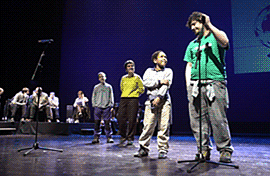
Bertsolaris these days are increasingly younger, and the art itself has rejuvenated to a more urbane style: Unai Iturriaga, Igor Elortza, Maialen Lujanbio … the story of the bertsolaris is now an everyday story, and they are to be found in the street, in the square, at the theatre, on the radio, web sites, magazines and almost anywhere.
Scripta manent, verba volant.
The capacity for working in new fields
The capacity for adapting itself to new fields is a feature of current bertsolaritza.
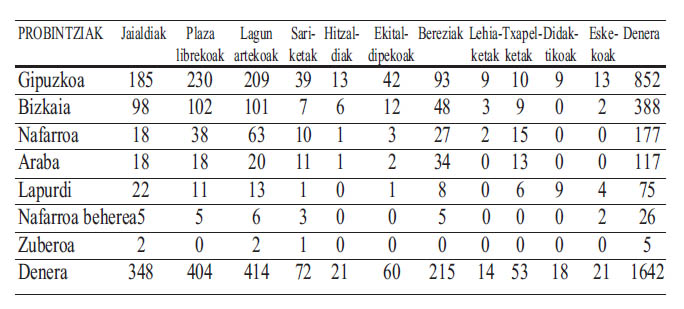
Explanation of headings
Jaialdiak : Festivals, 4 or more bertsolaris with a theme-setter
Plaza libreak: Free (themes non-directed): 2-3 bertsolaris without a theme-setter
Lagun artekoak: Amongst friends, At dinner parties and similar
Txapelketak: Championships, improvised: national, provincial or inter-schools.
Sariketak: Contests, improvised: contests organised by associations or local authorities
Hitzaldiak: Conferences, Any such organised talk where the theme is bertsolaritza.
Ekitaldipekoak: Sub-performances at events, performances undertaken at events not aimed at bertsolaritza as such (tributes, weddings, concerts ...)
Bereziak: Specials, Musical or experimental performances, or carried out with written bertsos
.
------------------------------------
See also: GARZIA, Joxerra. History of Improvised Bertsolaritza: A Proposal IN Oral Tradition Journal, 22-2 (2007). (en)